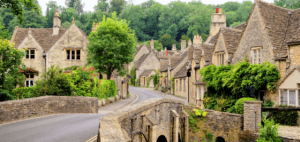Derry City | Londonderry, Northern Ireland

Updated On: April 18, 2024 by Ahmed Samir
Derry City, also known as Londonderry, is a city that has played a central role in Northern Ireland’s history and continues to thrive as a vibrant and resilient community. Located in the northwestern part of the island, along the River Foyle, Derry City is known for its stunning landscapes, rich cultural heritage, and complex history that has shaped the region. In this article, we will explore the multifaceted aspects of Derry City, from its history and culture to its modern-day identity and attractions.
A Rich and Diverse Heritage
Derry City’s history is a tapestry woven with conflict, resilience, and reconciliation threads. The city’s origins date back to the early 17th century when it was established as a plantation city by English and Scottish settlers. The city’s name, Derry, is derived from the Irish word “Doire,” meaning “oak grove.” However, the name controversy arises when some residents, especially from the unionist community, prefer to call it Londonderry, emphasizing its historical connection to London.
One of the most defining moments in Derry City’s history was the Siege of Derry in 1689. During the Williamite War in Ireland, the city endured a 105-day siege by Jacobite forces loyal to King James II. The Siege of Derry remains a potent symbol of Protestant and Unionist identity in Northern Ireland and is commemorated annually with the “Loyalist Apprentice Boys of Derry” parade.
The late 20th century brought a turbulent period to Derry City known as “The Troubles.” This conflict between Catholic nationalists and Protestant unionists led to a divided city, with barriers and walls erected to separate the two communities. The Bogside area of the city became infamous for the Bloody Sunday massacre in 1972, when British soldiers opened fire on unarmed civil rights marchers, resulting in 14 deaths. These events left deep scars on the city’s psyche and led to a prolonged period of tension.
Cultural Tapestry and Artistic Expression
Despite the city’s tumultuous history, Derry City boasts a rich cultural heritage that reflects its resilience and diversity. The city’s historic walls, built in the early 17th century, are a testament to its past. These well-preserved fortifications offer a unique opportunity for visitors to take a step back in time and explore the city’s history. Derry City is Ireland’s only remaining completely walled city, making it a significant historical attraction.
The city’s Guildhall, an iconic neo-gothic building overlooking the Peace Bridge, is another cultural gem. The Guildhall is an architectural masterpiece and an impressive collection of artefacts and exhibitions, including the stunning stained glass windows depicting the city’s history.
Derry City’s rich musical heritage is celebrated yearly with various festivals and events. The city is known for its traditional Irish music, and visitors can often find live performances in local pubs and venues. The Fleadh Cheoil, an annual traditional music festival, is a highlight for locals and tourists.
The Maiden City Festival is another cultural celebration in August each year. It showcases Derry City’s vibrant cultural scene, with music, dance, and art events highlighting its diverse traditions. The festival also celebrates the city’s history and heritage, making it a perfect time to visit for those interested in Derry’s cultural richness.
Modern-Day Derry City
In recent years, Derry City has made significant strides in overcoming its troubled past and redefining its identity as a peaceful and welcoming place. The Good Friday Agreement of 1998 marked a turning point in the city’s history, as it paved the way for peace and reconciliation between the two communities. Efforts to bridge divides and promote understanding have been ongoing, and the city has made significant progress in becoming a more inclusive and unified place.
One of the most prominent symbols of this reconciliation is the Peace Bridge, a pedestrian and cycle bridge that spans the River Foyle and connects the historically divided areas of the city. The bridge stands as a powerful symbol of unity and progress, and it has become a popular spot for locals and tourists to enjoy scenic walks and breathtaking views.
Derry City has also seen economic growth and development in recent years, with a thriving arts and cultural scene. The city’s Craft Village is a hub for artisans and craftspeople, offering a wide range of locally made products, from handmade jewellery to traditional Irish clothing. Additionally, the city has several theatres and galleries that showcase the talents of local artists and performers.
Discovering Derry City’s Top Attractions
Derry City has several attractions offering visitors diverse experiences, from historical sites to natural beauty and cultural gems. Here are some of the top attractions located in Derry City:
- The Walls of Derry: Derry City boasts the best-preserved city walls in Ireland, dating back to the early 17th century. Visitors can walk along the walls and enjoy panoramic views of the city and the River Foyle.
- Guildhall: The Guildhall is an iconic neo-gothic building in Derry City that houses an impressive collection of artefacts and exhibitions showcasing the city’s history. Its stunning stained glass windows are a highlight.
- Peace Bridge: This pedestrian and cycle bridge spans the River Foyle, connecting the historically divided areas of the city. It symbolizes unity and progress and offers a picturesque spot for a stroll.
- Tower Museum: Located within the city walls, the Tower Museum provides a comprehensive overview of Derry’s history through interactive exhibits, artefacts, and multimedia presentations.
- St. Columb’s Cathedral: This historic Anglican cathedral, built in the 17th century, is one of the city’s most recognizable landmarks. Its architecture and interior are worth exploring, and guided tours are available.
- The Playhouse Theatre: This vibrant arts venue hosts a variety of performances, including theatre, dance, music, and visual arts. Check their schedule for events and shows during your visit.
- Craft Village: Located within the city walls, the Craft Village is a hub for local artisans and craftspeople. Visitors can shop for handmade jewellery, traditional Irish clothing, ceramics, and other locally crafted goods.
- Bogside Murals: The Bogside area of Derry City is famous for its politically charged murals that tell the story of The Troubles and the city’s history. Guided tours are available to provide insight into the murals’ meanings.
- The Siege Museum: Located within the Apprentice Boys Memorial Hall, this museum delves into the history of the Siege of Derry, showcasing artefacts and providing historical context.
- The Foyle Maritime Festival: If you visit during this biennial festival, you’ll have the chance to experience a lively celebration of maritime culture, with tall ships, live music, and various nautical-themed events.
- Museum of Free Derry: This museum focuses on the civil rights movement, Bloody Sunday, and the events surrounding The Troubles. It provides a sombre but informative look at the city’s history.
- Creggan Country Park: Situated on the outskirts of Derry City, this park offers beautiful lakeside walks, outdoor activities, and a peaceful, natural escape from the urban environment.
- The People’s Gallery: Located in the city’s Rossville Street, this outdoor gallery showcases a series of murals portraying local people and their stories, reflecting the resilience and spirit of the community.
- Foyleside Shopping Centre: For those interested in shopping, Foyleside offers a range of retail stores, restaurants, and entertainment options in the city’s heart.
These attractions highlight the rich history, culture, and natural beauty of Derry City, making it a compelling destination for travellers interested in exploring Northern Ireland’s vibrant heritage.
Choosing the Ideal Season for Your Derry City Adventure
The best time to visit Derry City depends on your preferences and the type of experience you seek. Summer is the peak tourist season from June to August, offering warm weather, long daylight hours, and a bustling atmosphere with numerous festivals and outdoor activities. Spring and autumn, from March to May and September to November, respectively, provide milder temperatures, fewer crowds, and the opportunity to enjoy the city’s attractions and surrounding natural beauty without the summer rush.
Winter, from December to February, is ideal for history enthusiasts interested in indoor museums and cultural events, though the weather tends to be calmer and wetter. Ultimately, Derry City welcomes visitors year-round, so you can choose the season that aligns with your interests and travel plans to experience this historic and culturally rich city to the fullest.
Last Words
Derry City | Londonderry, Northern Ireland, is a city of remarkable historical significance and cultural richness. While its past has been marked by conflict and division, the city has made significant strides towards reconciliation and unity in recent years. With its well-preserved historical sites, vibrant cultural scene, and breathtaking natural beauty, Derry City is a destination that offers something for everyone.
As visitors explore the city’s historic walls, immerse themselves in its cultural heritage, and witness the symbols of peace and progress, they can see firsthand the resilience and determination of the people of Derry City. This resilient spirit and the city’s unique blend of history and modernity make it a truly captivating destination in Northern Ireland. Whether you’re interested in history and culture or simply enjoying the beauty of the landscape, Derry City is a place that will leave a lasting impression on all who visit.






